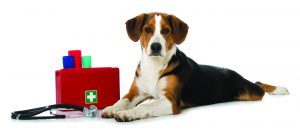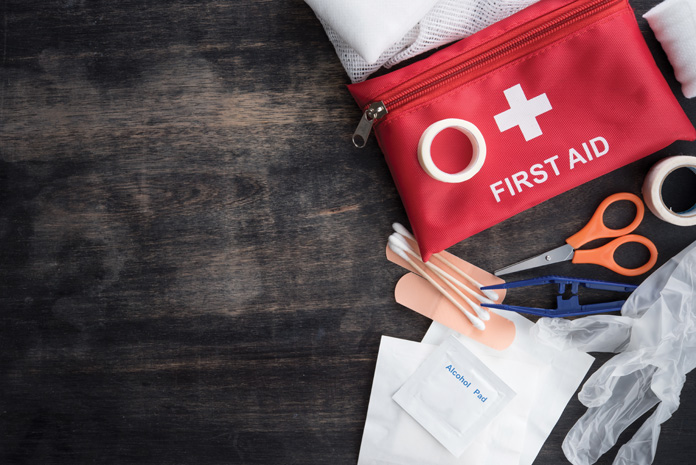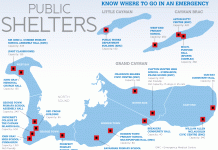First aid kits come in many shapes and sizes. You can purchase one from the Cayman Islands Red Cross, or you can make your own. A well-stocked first-aid kit can help you respond effectively to common injuries and emergencies.
For Your Family
Whether you buy a first aid kit or put one together, make sure it has all the items you may need:
- Include any personal items such as medications and emergency phone numbers or other items your healthcare provider may suggest.
- Check the kit regularly.
- Check expiration dates and replace any used or out-of-date contents.
The Cayman Islands Red Cross recommends that all first aid kits include the following:
- First aid Kit Box 1
- Multi trauma dressing 12×30 1
- Dynarex 1/2-inch cloth tape roll 1
- Dynarex 1-inch cloth tape roll 1
- Sterile 4×4 (8 ply) packages in 2’s 8
- Triangular bandage 40x40x56 2
- Sterile 5×9 gause pads 5
- 1×3 plastic adhesive bandage 100 per box 1
- Small trauma scissor 1 pair
- Latex free gloves 1 pair
- Ammonia inhalants 10 per box 1
- Soothe A sting swabs 10 per box 1
- Irrigating eye solution 4 oz 1
- Instant junior ice pack 2
- CPR shield barrier 1
- Providone iodine prep pads 100 10
- Ace bandage 3 inch 1
For Your Pet
 Cayman Islands Veterinary Medical Association
Cayman Islands Veterinary Medical Association
[email protected]
Having a basic first aid kit is essential as a pet owner. In a medical or climatic emergency, it is always better to be organized and ready to act. Most items found in a pet first aid kit are identical to those found in a human first aid kit, which should be present in every household.
Below is a basic checklist of items to include in your pet’s first aid kit:
- IMPORTANT CONTACT NUMBERS (veterinarian, Department of Agriculture, Humane Society, animal control, police)
- A copy of your pet’s MEDICAL RECORDS (including medications and vaccination history)
- LATEX GLOVES to protect against contamination of self or pet wounds, or for cleaning up pet excreta
- DIGITAL FEVER THERMOMETER – to take your pet’s temperature. Know the normal ranges for your cat (100.5-102.5 F) or dog (100.2-103.8 F) and take a rectal (not an oral) temperature with the use of KY jelly or another lubricant
- MUZZLE (gauze, rope, necktie, nylon stocking, commercial muzzle) to prevent bites (do not muzzle vomiting pets!)
- SPARE LEASH AND COLLAR to help restrain animals who become fearful, aggressive, or unpredictable after injury/climatic emergencies
- GAUZE ROLL for wrapping wounds or to use as a muzzle
- CLEAN TOWELS to help restrain cats, cleaning, or to use as padding
- NONSTICK BANDAGES OR STRIPS OF CLEAN CLOTH to protect wounds or control bleeding
- SELF-ADHERING, NONSTICK TAPE for bandages
- ADHESIVE TAPE for securing bandages (do not use human adhesive bandages such as Band Aids on pets)
- SCISSORS to cut tape and other bandage material
- EYE DROPPER (or large syringe without needle) to flush wounds or administer oral medications
- KY JELLY (or generic version) to protect wounds and eyes
- MILK OF MAGNESIA OR ACTIVATED CHARCOAL to absorb toxins/poisons (always contact your veterinarian before inducing vomiting or treating an animal for poison)
- HYDROGEN PEROXIDE (3 percent) to induce vomiting (always contact your veterinarian before inducing vomiting or treating an animal for poison)
- SALINE SOLUTION or WATER for flushing/cleaning wounds
- DISH SOAP or BETADINE SCRUB SOLUTION for removing toxins from the skin and fur. Remember to rinse thoroughly with water and dry your pet afterwards
- MEDICATIONS (both prescription and routine preventative medications)
- LOCATION OF PET CARRIER
Always remember that any first aid administered to your pet should be followed by immediate veterinary care. First aid care is not a substitute for veterinary care, but it may save your pet’s life until it receives veterinary treatment.
Disaster evacuation plans for your family should also include plans for your pet. A pre-determined disaster plan will help you remain calm, allow you to think clearly, and act wisely. Contact your pet’s veterinarian or the Cayman Islands Department of Agriculture to learn more about travel requirements for pets.








